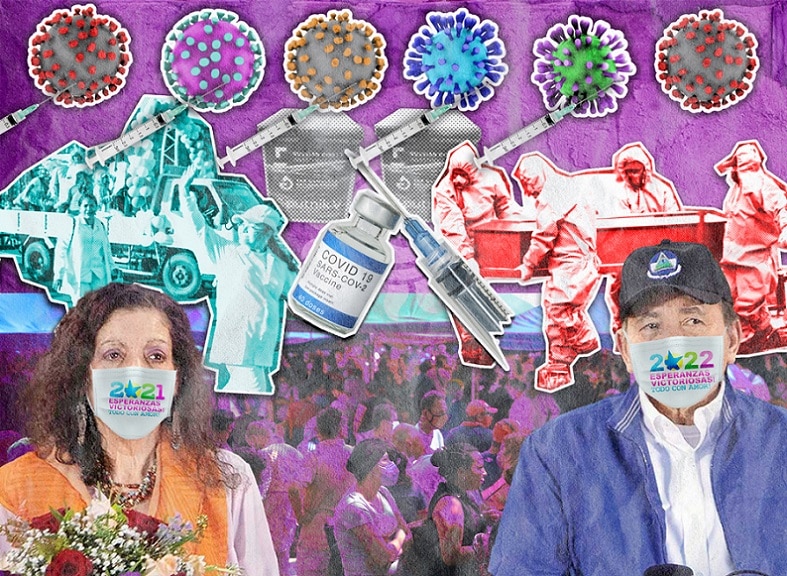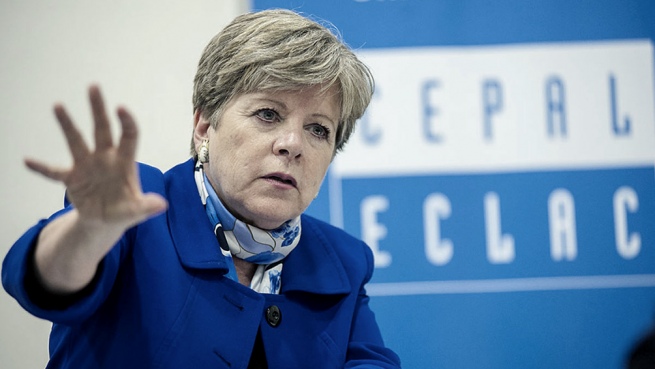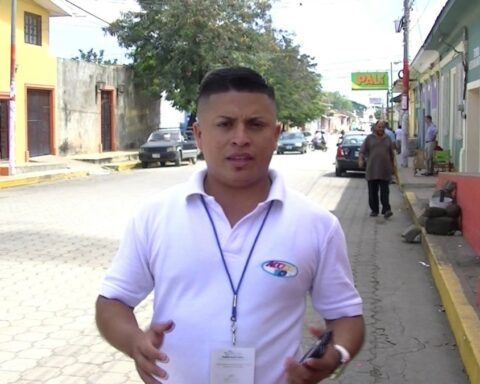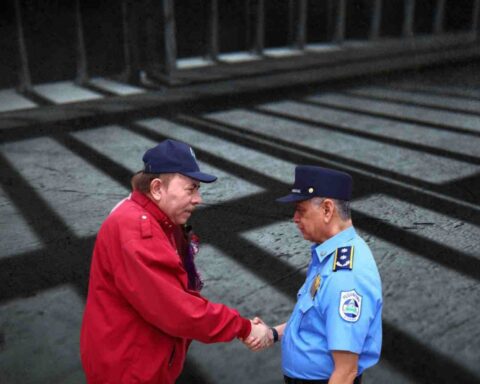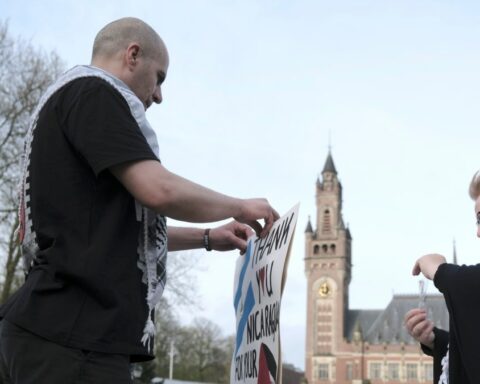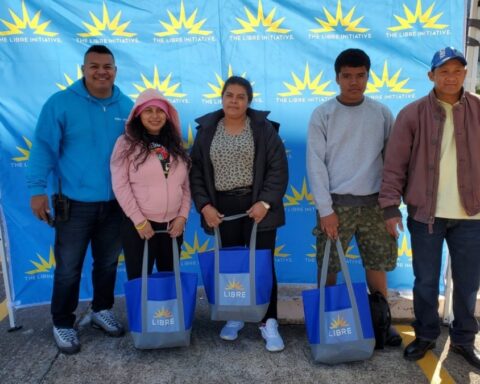Today marks two years since the confirmation of the first positive case of SAR-CoV-2 in Nicaragua. The beginning of a humanitarian tragedy that the Government of Daniel Ortega and Rosario Murillo has openly minimized and hidden. Although the footprint of covid-19, among those who got sick and those who lost their loved ones, is undeniable.
In official figures, the pandemic left a total of 18,688 infected people, of these 13,855 recovered and 228 died. These statistics are the lowest in the region, but at the same time the most questionable. The Citizen Observatory, which keeps an independent count, calculates that in these two years of the pandemic there were 32,110 cases and 5,988 suspected deaths from the virus. Meanwhile, excess mortality studies estimate between 14,800 and 33,400 deaths attributable to the new coronavirus.
The covid-19 that in Nicaragua also translated into threats and reprisals against the health workers who gave their opinion about the behavior and impact on the population. Meanwhile, the State imposed secrecy and opacity, which after two years have not allowed a “comprehensive assessment” of the management of the pandemic, according to the Pan American Health Organization (PAHO). These are the ten moments that summarize the passage of covid in the country.
Ortega prescribed “Love in times of covid”
Four days before the first positive case of SAR-CoV-2 was confirmed, the Government of Daniel Ortega and Rosario Murillo ordered doctors and health personnel to lead a march baptized: “Love in times of Covid-19”. This was the prelude to the mismanagement of the pandemic in Nicaragua, which months later was characterized by Ortega’s reluctance to close borders, declare forty or impose restrictive measures, so as not to affect the country’s economy, which had been fractured by the social crisis and policy since 2018.
“In the midst of this pandemic, work has not stopped, because here if work stops, the country dies, and if the country dies, the people die,” Ortega said on April 15, 2020, in his first television channel made during the health emergency and after 34 days of absence.
Two years later, little is officially known about the impact of the pandemic in Nicaragua. There is no report on the occupation of beds with covid patients, nor are there official records on the impact by departments, gender or sex.
The first wave and denial
Nicaragua experienced its first wave of covid-19 without the authorities alerting what was happening. The cases began to rise the month after the first case was identified, on March 18, 2020, and deaths skyrocketed in May and June of that year, without there being a national alert or extreme measures to prevent them.
The first indication of the impact of covid-19 was the unusual increase in deaths from atypical pneumonia, one of the causes that was later discovered, which the Minsa used to classify deaths from covid-19 and thus reduce the statistics. Consequently, the Government ordered to suspend the publication of the death figures disclosed in the epidemiological bulletins.
In the three months that this first wave lasted, which occurred between May and July 2020, the Minsa reported 112 deaths, half of the official deaths accumulated in two years. But there were more deaths, in those months hundreds of people were expressly buried at night or early in the morning. According to studies of excess mortality, the number of deaths exceeded 6,000.
excess mortality
In Nicaragua, studies on excess mortality have served to bring the population closer to knowing the real impact of the pandemic in the face of the lack of information and the little credibility of the figures from the Ministry of Health (Minsa), who report the unlikely death of one weekly from October 2020.
The last calculation of excess mortality made at the national level was carried out by CONFIDENCIAL, based on four causes of death related to covid-19: heart attacks, diabetes, pneumonia and hypertension and it was estimated that during the first 21 months of the pandemic there were more than 14,800 attributable deaths, but were classified by these other causes. This figure rises to 20,264 if eleven other “comorbidities” that also multiplied in both years of the pandemic are included, according to the Minsa Health Map.
But the calculation of this tragedy, not recognized by the State, is even greater, according to a recent study by the Institute for Health Metrics and Evaluation (IHME) of the University of Washington, United States. They calculate an excess mortality of 33,400 deaths attributable to covid-19 between 2020 and 2021.

The imposition of a weekly death
Nicaragua has been reporting a weekly death due to covid-19 for 17 consecutive months. A statistically improbable figure, which did not change even when the country suffered the second wave of the pandemic, which occurred between August and October 2021, which left more infected and hospitalized than the first.
In the opinion of the Israeli researcher, Ariel Karlinsky, who has compiled and analyzed excess mortality worldwide, the report of deaths in Nicaragua is a falsification. “It seems that someone takes the true data but reduces it, so (the infections) seem like real data, but the data on deaths have no logic, ”he assured. CONFIDENTIAL.
The persecution of doctors
During the two years of the pandemic, the Minsa carried out a series of dismissals, restrictions, and reprisals against doctors. In the first year, the authorities canceled the contracts of 31 toilets, the common denominator of these was that they signed public letters requesting personal protective equipment. Many of these have not yet been paid their employment benefits.
In 2021, the pressure on healthcare personnel increased. The Minsa summoned more than a dozen doctors to threaten them with taking away their licenses and remind them of the existence of the Cybercrime Law or Gag Law. The Ortega government publicly accused the doctors and journalists of committing “pandemic terrorism.”

Faced with the threats and pressure, which coincided with the wave of arrests of opponents, many doctors went into exile and others remained silent. To date, those who give their opinion do so anonymously to protect themselves. The Government also canceled the legal status of at least 15 medical organizations that had between seven and 40 years of experience.
The promotion of crowds
In Nicaragua there were never any restrictions on movement or the imposition of masks as there was in the rest of the nations. Rather, the authorities promoted more than 4,500 activities on weekends, including recreational, cultural, religious and sports activities, which did not stop even when the two waves of covid reached the highest peaks of infections, hospitalizations and deaths.
The Ortega government even ordered the mayors to carry out religious celebrations on their own, despite the fact that the Catholic Church decided to postpone them so as not to expose the population to contagion. This happened with the patron saint festivities of Santo Domingo and San Jerónimo that were organized by the mayor’s offices.

The vaccination that came late
Nicaragua faced the resurgence of covid-19 caused by the variants of concern without having its population immunized. While the rest of the nations were equipped with anticovid vaccines, the country spent the first ten months of 2021 as the second nation in America with the fewest people vaccinated.
Given the shortage of vaccines, more than one hundred thousand Nicaraguans traveled to neighboring countries in search of doses. Meanwhile, hundreds of others waited outside the hospitals designated as vaccination posts, starting the day before to be vaccinated.
The wait ended in the last quarter of 2021 when the country received more than nine million doses from donations and direct purchases. After this supply, the Minsa carried out an intense vaccination campaign with which it has already managed to vaccinate 60% of Nicaraguans, but as revealed CONFIDENTIALthe inhabitants of the Caribbean Coast -the poorest in the country- are those with the lowest percentage of vaccinated population.
the second wave
The second wave of covid-19 hit Nicaragua in 2021 and made it stronger than the first. The outbreak arrived in August and lasted throughout September and October, exceeding the capacity of several public hospitals, with an increase in infections that not even the Ministry of Health (Minsa) could hide.
In those months, the reports from the Minsa and the Observatory separately exceeded the weekly records of infections that were recorded during the first wave of 2020. Hospitalizations skyrocketed to the point where the German Nicaraguan Hospital had to dedicate itself exclusively to “patients covid” and expanded the number of beds to 500.
And while the Minsa kept silent about the collapse in hospitalizations, the population that became ill overflowed in search of oxygen tanks for patients who were struggling from home. According to doctors at public hospitals, many patients died waiting their turn to be connected to a ventilator.
Minsa is silent about variants of SAR-CoV-2
Before the second wave of covid-19 reached its peak, the medical staff of several hospitals in the country reported suspected cases of the delta variant. At that time, the infections were already on the rise, but they still had not surpassed the 2020 outbreak. However, the Minsa – which had the team to look for the variants since May – did not alert the population about the circulation of this strain.
It was not until November 16, when the wave had already passed, that the Minsa informed PAHO about the circulation of the alpha, beta, gamma and delta variants of concern. The latter would have triggered the second wave.
Despite this experience, which could have prevented the deaths of hundreds of Nicaraguans, the Minsa did not report on the circulation of the omicron variant either. It was again PAHO who confirmed the presence of this strain in one of its weekly press conferences.
Slow budget execution despite the health crisis
The second year of the pandemic closed with a slow budget execution, despite the shortage of vaccines and the impact of the second wave. As reported by the Ministry of Finance and Public Credit, until September 2021, 5014.7 million córdobas were available for the covid-19 pandemic, but until then only 20.5% had been executed.
The slow execution was accompanied by little progress in the transparency agreements that the Government established with multilateral financing organizations. In which he promised to reveal real-time figures on infections and deaths, lethality, PCR tests carried out and their results, expenses related to the pandemic, room updates and epidemiological bulletins.

